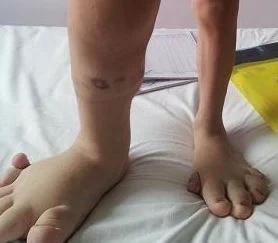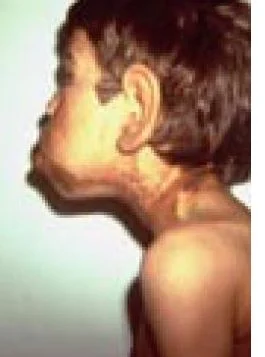A 30 y.o. woman presents to the the psychiatric area of the ED with refusal to eat. In her evaluation for altered mental status she gets a head ct.
What do you notice?
Our patient had Proteus syndrome. It is a rare somatic mutation that results in asymmetric overgrowth of bone and soft tissue.It was first described in 1979 and four years later was given the name "Proteus syndrome" after the Greek god Proteus who was able to assume multiple forms. It is characterized by macroglossia, hemifacial overgrowth and hyperpigmentation.
aymmetric growth of the legs
Genetic sequencing has localized the gene responsible to AKT1. This is not in a germ cell and so can occur later in life. If it develops later in life the phenotype will be less severe.
ear enlargement from Proteus syndrome
Joseph Merrich, the man studied in the 19th century by Treves who was thought to have neurofibromatosis is now thought to have had Proteus syndrome. Our patient had such severe bony overgrowth of the jaw she could barely open her mouth. She was scheduled for reconstructive surgery.
Lindhurst MJ, Sapp JC, Teer JK, et al. Mosaic activating mutation in AKT1 associated with the Proteus syndrome. 2011 NEJM Aug 18, 365(7).
Cohen MM Jr, Proteus syndrome; an update. 2005 Am J Med Gen Seminars in Med. Aug 115 137C(1) 38-52.
Lacerda LS, Alves UD, Zanier et al. . 2014 Differential diagnosis of overgrowth syndromes; the most important clinical and radiologic manifestations. Radiol Reg Prac :947451


